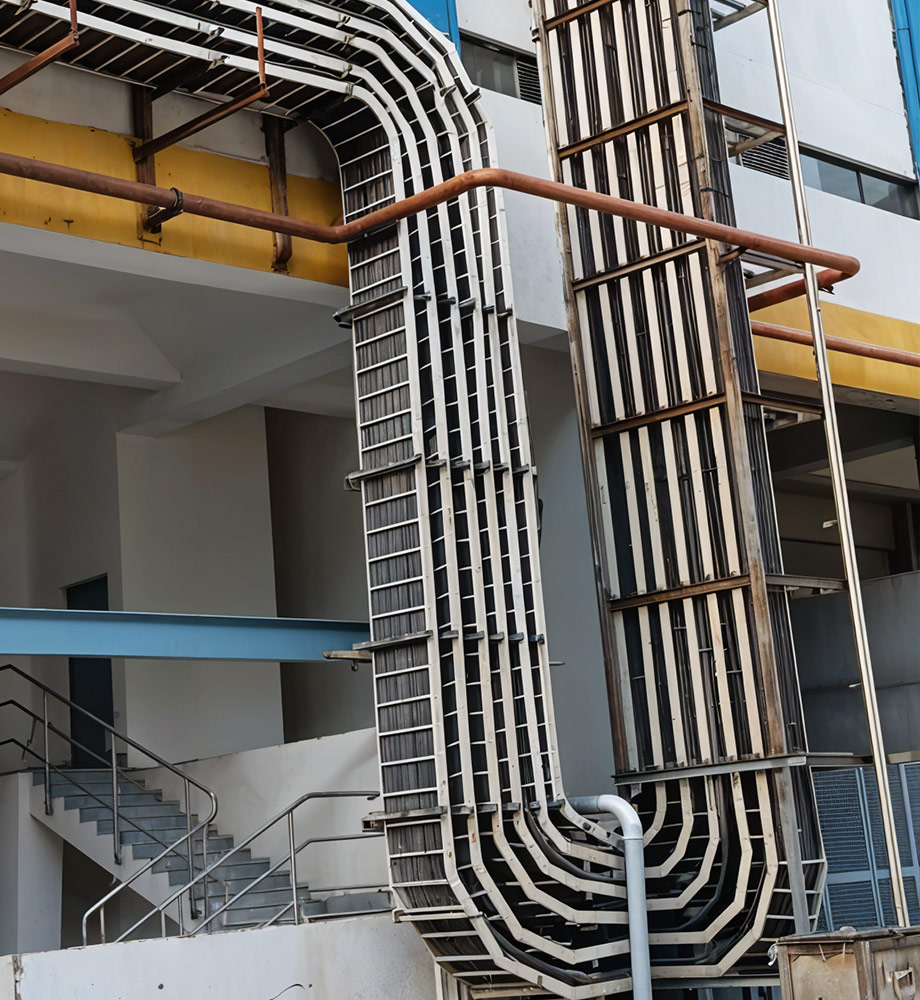Key Features
- High Corrosion Resistance: No rusting in acid, saline or chemical atmospheres.
- High Strength-to-Weight: Supports heavy cable bundles while remaining light and easy to handle.
- Non-Conductive Material: Fiberglass construction provides electrical insulation and immunity to electromagnetic interference.
- Fire-Retardant Construction: Standard FRP trays meet fire safety requirements and self-extinguish if ignited.
- Variety of Styles: Ladder, channel, solid-bottom, perforated and wire-mesh designs to match installation needs.
- UV- and Weather-Stable: Suitable for outdoor use (UV inhibitors prevent sun damage).
- Accessory Compatibility: Available with matching FRP covers, couplers, drops, hangers and support hardware.
Benefits
- Longevity: FRP trays last far longer than galvanized steel in harsh settings (no corrosion failures).
- Low Maintenance: Once installed, little upkeep is required beyond occasional cleaning.
- Safety: Non-sparking and non-magnetic – safe for explosive, EMI-sensitive and high-voltage environments.
- Easy Installation: Lightweight sections reduce labor and can be cut or drilled on-site without specialized tools.
- Versatility: Adaptable to complex cable routing (fits gutters, ceilings, rooftop walkways) and retrofits readily over existing trays.
- Cost-Effectiveness: Lower life-cycle costs due to reduced replacement and maintenance.
Applications
- Corrosive Process Industries: Chemical plants, refineries, oil & gas platforms (cable support in acid or saline atmospheres).
- Power & Utility: Cable distribution in power plants, substations and renewable energy installations (non-conductive properties are advantageous).
- Infrastructure & Transportation: Tunnels, bridges, railways, and metros where exposure to moisture or salt requires non-corroding trays.
- Water/Wastewater & Marine: Pump stations, treatment facilities and docks (UV- and salt-resistant).
- Commercial Buildings: Parking garages, stadiums and malls (long spans, lightweight walkways).
- Telecommunications: Data center and telecom fiber cables (non-conductive tray avoids grounding issues).
Technical Specifications
- Construction: Pultruded fiberglass rods and molded connectors, typically in polyester or vinylester resin.
- Section Sizes: Widths from ~50 mm to 300 mm (or more) and depths of 50 mm, 75 mm, 100 mm, etc. (e.g. 50 mm and 80 mm depths are common).
- Span Rating: Engineered to industry-standard load classes (tray spans of 1–3 meters, carrying capacities up to several hundred kg/m).
- Trays Lengths: Standard lengths 2–3 m; field-cuttable.
- Finish: Standard colors (gray, yellow) with optional texture or slip-resistive grit.
- Standards: Designed per NEMA VE 1/VE 2 or equivalent cable tray standards; can be rated for NEMA 4X/IP66 environments.
- Accessories: Compatible FRP bends, tees, reducers, dropouts, and bolted connectors.
Unique Selling Points (USPs)
- Extreme Corrosion Tolerance: Engineered for continuous duty in the harshest chemical environments – one non-metallic tray can serve many aggressive areas.
- Complete FRP Systems: From standard ladder trays to ventilated and solid-bottom runs, we offer every tray type in FRP along with covers and accessories for turnkey solutions.
- Fire & Smoke Options: Our FRP trays use fire-retardant resin systems (and optional low-smoke additives) to meet high-safety building codes.
- Lightweight Advantage: Up to 70% lighter than steel, greatly reducing shipping and installation costs while still providing rigidity.
- Electrical Isolation: Ideal for tie-wrapping electrical cables and fiber optics without interference; also eliminates grounding complications.
- Rapid Deployment: Pre-fabricated modular sections allow quick assembly on-site, even in remote or high-elevation projects.

